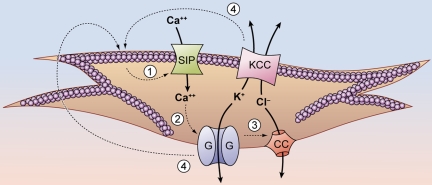Abstract
In this issue of Blood, Ataga and colleagues report that treatment of sickle cell disease patients with senicapoc, a Gardos channel inhibitor, reduces the number of dehydrated cells, increases hemoglobin levels, and diminishes hemolysis.
The journey from laboratory bench to this clinical study began half a century ago with 2 independent observations. In 1958, the Hungarian physiologist Gyorgy Gárdos described calcium-dependent potassium loss from red cells.1 The “Gardos pathway” is now known to be mediated by a calcium-activated K channel. D. C. Tosteson's seminal studies of abnormal cation content and permeability in sickle cells2 led to the characterization of dehydrated cells with high hemoglobin concentration. The importance of these dehydrated cells was reinforced by subsequent discoveries that polymerization is exquisitely sensitive to Hb S concentration, and that dehydrated sickle cells are very short-lived, selectively trapped in the microcirculation, and removed during vaso-occlusive episodes.
Sickle cell dehydration is thought to result from a complex interplay of Hb S polymerization and several cation transport systems in sickle cells. A transport pathway that normally regulates volume in reticulocytes, the potassium-chloride cotransporter (KCC) appears to function pathologically in sickle cells, overshooting its target hemoglobin concentration3 and priming the reticulocyte to sickle. Hb S polymerization activates a nonselective cation leak pathway in a fraction of sickle cells upon deoxygenation. Calcium entry via this sickling-induced pathway triggers activation of the Gardos channel, which mediates rapid KCl and water loss.4 Abnormal KCC activity in the sickle reticulocyte may thus facilitate a vicious spiral in which sickling and Gardos channel activation reinforce each other to dehydrate the cell. In vitro and animal studies have been insufficient, however, to elucidate how these pathways interact in vivo. Brugnara's pioneering clinical investigation of another Gardos channel blocker, clotrimazole,5 laid the foundation for the development of senicapoc. The demonstration in the current study that senicapoc reduces the number of dense sickle cells establishes conclusively that the Gardos pathway is active in vivo and contributes to sickle cell dehydration.
Ataga and colleagues show that senicapoc treatment was well-tolerated, resulted in increased hemoglobin, and reduced markers of hemolysis—reticulocyte count, bilirubin, LDH levels—strongly suggesting that sickle cell survival was improved. Thus, the study demonstrates that prevention of dehydration in a clinical setting is feasible and decreases in vivo hemolysis in sickle disease.
Recently, a phase 3 trial of senicapoc was terminated early because of low probability of achieving a reduction in crisis rate, the primary clinical end point.6 Laboratory endpoints of increased hemoglobin and reduced hemolysis confirmed the findings of the phase 2 study reported here. These results appear to reinforce clinical observations made decades ago that the number of dense (or irreversibly sickled) cells correlates with hemolysis7 but not with frequency of pain episodes.8 This is consistent with the concept that the hemolytic and vaso-occlusive components of sickle cell disease represent distinct, albeit interactive, pathophysiological mechanisms. The contribution of hemolysis to vasculopathy in sickle cell disease has been emphasized by demonstration of nitric oxide scavenging by plasma hemoglobin. Clinical complications associated with hemolysis include leg ulcers, priapism, stroke, and pulmonary hypertension, which, although insidious and gradual in onset, appears to be a major cause of death in sickle cell disease.9
Transport pathways contributing to sickle cell dehydration. Hemoglobin (Hb) S polymerization activates the sickling-induced pathway, permitting Ca++ entry. Increased cytoplasmic Ca++ activates the Gardos pathway, which mediates rapid K+ efflux, balanced by Cl− exit via a chloride conductance pathway. High Hb S concentration resulting from abnormal regulation of K:Cl cotransport may potentiate Hb S polymerization in reticulocytes. Once initiated, the vicious cycle of sickling and dehydration intensifies and perpetuates itself. KCC indicates K:Cl cotransporter; SIP, sickling-induced pathway; G, Gardos pathway; and CC, Cl conductance pathway.
Gardos channel inhibitors, as well as drugs targeting other dehydrating cation transporters, may ultimately play an important role in reducing the hemolytic complications of sickle cell disease. However, assessment of the clinical endpoints associated with hemolysis, such as stroke and pulmonary hypertension, is a formidable challenge in clinical trials because such endpoints manifest sporadically or over an extended period of time. But then, the pathway from bench to bedside for any therapy is rarely straight.
Footnotes
Conflict-of-interest disclosure: C.H.J. participated as a site investigator in the phase 3 trial of senicapoc, funded by Icagen (Durham, NC)/McNeil (Fort Washington, PA). He has been a paid consultant for Icagen. ■
REFERENCES
- 1.Gardos G. The function of calcium in the potassium permeability of human erythrocytes. Biochim Biophys Acta. 1958;30:653–654. doi: 10.1016/0006-3002(58)90124-0. [DOI] [PubMed] [Google Scholar]
- 2.Tosteson D, Shea E, Darling RC. Potassium and sodium in red blood cells in sickle cell anemia. J Clin Invest. 1952;48:406–411. doi: 10.1172/JCI102623. [DOI] [PMC free article] [PubMed] [Google Scholar]
- 3.Joiner C, Rettig RK, Jiang M, Risinger M, Franco PS. Urea stimulation of KCl cotransport induces abnormal volume reduction in sickle reticulocytes. Blood. 2007;109:1728–1735. doi: 10.1182/blood-2006-04-018630. [DOI] [PMC free article] [PubMed] [Google Scholar]
- 4.Lew VL, Etzion Z, Bookchin RM. Dehydration response of sickle cells to sickling-induced Ca(++) permeabilization. Blood. 2002;99:2578–2585. doi: 10.1182/blood.v99.7.2578. [DOI] [PubMed] [Google Scholar]
- 5.Brugnara C, de Franceschi L, Alper SL. Inhibition of Ca(2+)-dependent K+ transport and cell dehydration in sickle erythrocytes by clotrimazole and other imidazole derivatives [see comment]. J Clin Invest. 1993;92:520–526. doi: 10.1172/JCI116597. [DOI] [PMC free article] [PubMed] [Google Scholar]
- 6.Icagen, Inc. Press Release. Business Wire. 2007 Apr 3; [Google Scholar]
- 7.Serjeant GR, Serjeant BE, Milner PF. The irreversibly sickled cell; a determinant of haemolysis in sickle cell anaemia. Br J Haematol. 1969;17:527–533. doi: 10.1111/j.1365-2141.1969.tb01403.x. [DOI] [PubMed] [Google Scholar]
- 8.Ballas SK. Sickle cell anemia with few painful crises is characterized by decreased red cell deformability and increased number of dense cells. Am J Hematol. 1991;36:122–130. doi: 10.1002/ajh.2830360211. [DOI] [PubMed] [Google Scholar]
- 9.Kato GJ, Gladwin MT, Steinberg MH. Deconstructing sickle cell disease: reappraisal of the role of hemolysis in the development of clinical subphenotypes. Blood Rev. 2007;21:37–47. doi: 10.1016/j.blre.2006.07.001. [DOI] [PMC free article] [PubMed] [Google Scholar]



